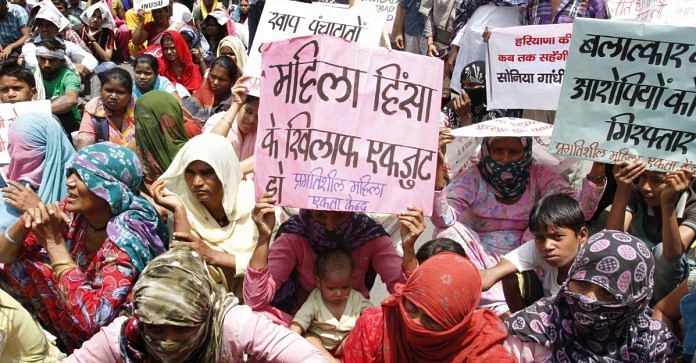According to NCRB data, 13.9 per cent of all atrocities against SCs and 14.8 per cent of all crimes against STs were rape or sexual assault.
New Delhi: There has been a long-held – although disputed – feminist argument that rape is about power, not sexual gratification. India’s latest crime statistics seem to back this belief, experts said.
Since 2014, sexual violence against the Scheduled Castes (SC) has been the most dominant form of atrocities perpetrated against the marginalised group, and has been increasing marginally each year.
According to the latest National Crime Records Bureau statistics, 13.9 per cent of all atrocities committed against SCs included rape or sexual assault. In 2015 and 2014, these crimes constituted 12.73 per cent and 10.9 per cent of all crimes respectively.
In 2016, similar patterns were recorded against Scheduled Tribes (ST). Rape accounted for 14.8 per cent of all crimes reported against STs, followed only by 12.7 per cent cases of assault on women, with intent to outrage their modesty.
About 973 cases of rape were reported in 2016 against ST women, whereas 2,541 cases of rape were reported against SC women.
Not a surprise
Experts say the data is not surprising in the least. While there’s much to be said about gender violence in general, in a society saturated with caste hierarchies, sexual violence becomes yet another way to assert the violability of lower castes, they argue.
“Caste is an instrument of patriarchy, and a system of dominance and oppression. To keep control over lower castes, one of the easiest ways is to violate the bahu-betis of the Dalit community,” says Ranjana Kumari, director of the Centre for Social Research.
The lack of access to law enforcement for Dalits makes matters worse, argues Kumari. While it is not unusual for caste women to be dismissed by the police, the occurrence of the phenomenon is much higher with Dalit and Adivasi women, she says.
The social subordination of Dalit men makes them incapable of providing any security to “their” women, she says, as opposed to men from dominant castes, who are seen as ‘virile’ enough to guard the women of their communities.
Why the rising numbers?
But what explains the percentage increase over the last few years? While greater reporting of crimes against the marginalised may be one of the more obvious explanations, that alone doesn’t explain the rise.
“Given the agrarian crisis, violence against marginalised communities is bound to increase,” argues Ritambhara Hebbar, chairperson at the Centre for Study of Developing Societies at the Tata Institute of Social Sciences, Mumbai. Dominant castes do not find the subservience from lower caste groups that they have been traditionally used to, thus making them uneasy.
Further, with men from lower caste groups increasingly migrating to cities and urban areas in search of employment, women of their families are rendered vulnerable back in their villages.
The same holds true for adivasi women, Hebbar explains. “With widespread displacement of adivasis, women lose the secure conditions of life, making them vulnerable to sexual attacks,” she says.
Political assertion by Dalits is another reason for the increase in attacks against them, adds Kumari. “Wherever Dalits assert themselves, there is a concerted attempt to crush them, and sexual attacks on Dalit women are part of this,” she says.
While all this remains true, NCRB data reveals yet again that the majority of cases under all crimes against women are perpetrated by their husbands or the husband’s relatives. It is not as though SC/ST women are shielded from this violence within the domestic sphere. “Let’s not pretend like Dalit men do not perpetrate violence on women in their own families,” Kumari says.
With inputs from Apurva Vishwanath.



